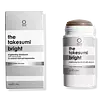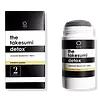What's inside
What's inside
 Key Ingredients
Key Ingredients

 Benefits
Benefits

 Concerns
Concerns

 Ingredients Side-by-side
Ingredients Side-by-side

Water
Skin ConditioningPropylene Glycol
HumectantEuphorbia Cerifera Wax
Maranta Arundinacea Root Powder
Skin ConditioningAloe Barbadensis Leaf Juice
Skin ConditioningSaccharomyces Ferment
Skin ConditioningSodium Stearate
CleansingStearyl Alcohol
EmollientBenzyl Alcohol
PerfumingSalicylic Acid
MaskingGlycerin
HumectantSorbic Acid
PreservativeCharcoal Powder
AbrasiveChamomilla Recutita Flower Extract
MaskingNiacinamide
SmoothingAlpha-Arbutin
AntioxidantCitrus Grandis Seed Extract
AstringentParfum
MaskingWater, Propylene Glycol, Euphorbia Cerifera Wax, Maranta Arundinacea Root Powder, Aloe Barbadensis Leaf Juice, Saccharomyces Ferment, Sodium Stearate, Stearyl Alcohol, Benzyl Alcohol, Salicylic Acid, Glycerin, Sorbic Acid, Charcoal Powder, Chamomilla Recutita Flower Extract, Niacinamide, Alpha-Arbutin, Citrus Grandis Seed Extract, Parfum
Glycerin
HumectantWater
Skin ConditioningMaranta Arundinacea Root Powder
Skin ConditioningPropanediol
SolventSodium Stearate
CleansingHydrated Silica
AbrasiveSaccharomyces Ferment Filtrate
HumectantAloe Barbadensis Leaf Juice
Skin ConditioningMaltodextrin
AbsorbentAllantoin
Skin ConditioningSalicylic Acid
MaskingSorbic Acid
PreservativeCharcoal
AbrasiveMagnesium Hydroxide
AbsorbentBenzyl Alcohol
PerfumingPotassium Sorbate
PreservativeSodium Benzoate
MaskingCitrus Sinensis Peel Oil Expressed
PerfumingCitrus Aurantium Bergamia Fruit Oil
MaskingCitrus Grandis Peel Oil
MaskingGlycerin, Water, Maranta Arundinacea Root Powder, Propanediol, Sodium Stearate, Hydrated Silica, Saccharomyces Ferment Filtrate, Aloe Barbadensis Leaf Juice, Maltodextrin, Allantoin, Salicylic Acid, Sorbic Acid, Charcoal, Magnesium Hydroxide, Benzyl Alcohol, Potassium Sorbate, Sodium Benzoate, Citrus Sinensis Peel Oil Expressed, Citrus Aurantium Bergamia Fruit Oil, Citrus Grandis Peel Oil
Ingredients Explained
These ingredients are found in both products.
Ingredients higher up in an ingredient list are typically present in a larger amount.
Aloe Barbadensis Leaf Juice comes from leaves of the aloe plant. Aloe Barbadensis Leaf Juice is best known for helping to soothe sunburns. It is also anti-inflammatory, moisturizing, antiseptic, and can help heal wounds.
Aloe is packed with good stuff including Vitamins A, C, and E. These vitamins are antioxidants, which help fight free-radicals and the damage they may cause. Free-radicals are molecules that may damage your skin cells, such as pollution.
Aloe Barbadensis Leaf Juice also contains sugars. These sugars come in the form of monosaccharides and polysaccharides, folic acid, and choline. These sugars are able to help bind moisture to skin.
It also contains minerals such as calcium, 12 anthraquinones, fatty acids, amino acids, and Vitamin B12.
Learn more about Aloe Barbadensis Leaf JuiceBenzyl Alcohol is most commonly used as a preservative. It also has a subtle, sweet smell. Small amounts of Benzyl Alcohol is not irritating and safe to use in skincare products. Most Benzyl Alcohol is derived from fruits such as apricots.
Benzyl Alcohol has both antibacterial and antioxidant properties. These properties help lengthen the shelf life of products. Benzyl Alcohol is a solvent and helps dissolve other ingredients. It can also improve the texture and spreadability.
Alcohol comes in many different forms. Different types of alcohol will have different effects on skin. This ingredient is an astringent alcohol.
Using high concentrations of these alcohols are drying on the skin. They may strip away your skin's natural oils and even damage your skin barrier. Astringent alcohols may also irritate skin.
Other types of astringent alcohols include:
According to the National Rosacea Society based in the US, you should be mindful of products with these alcohols in the top half of ingredients.
Any type of sanitizing product will have high amounts of alcohol to help kill bacteria and viruses.
Learn more about Benzyl AlcoholGlycerin is already naturally found in your skin. It helps moisturize and protect your skin.
A study from 2016 found glycerin to be more effective as a humectant than AHAs and hyaluronic acid.
As a humectant, it helps the skin stay hydrated by pulling moisture to your skin. The low molecular weight of glycerin allows it to pull moisture into the deeper layers of your skin.
Hydrated skin improves your skin barrier; Your skin barrier helps protect against irritants and bacteria.
Glycerin has also been found to have antimicrobial and antiviral properties. Due to these properties, glycerin is often used in wound and burn treatments.
In cosmetics, glycerin is usually derived from plants such as soybean or palm. However, it can also be sourced from animals, such as tallow or animal fat.
This ingredient is organic, colorless, odorless, and non-toxic.
Glycerin is the name for this ingredient in American English. British English uses Glycerol/Glycerine.
Learn more about GlycerinWe don't have a description for Maranta Arundinacea Root Powder yet.
Salicylic Acid (also known as beta hydroxy acid or BHA) is a well-known ingredient for treating skin that struggles with acne and clogged pores. It exfoliates both the skin's surface and deep within the pores to help clear out buildup, control oil, and reduce inflammation.
Unlike AHAs (alpha hydroxy acids), salicylic acid is oil-soluble. This allows it to penetrate into pores which makes it especially effective for treating blackheads and preventing future breakouts.
Salicylic acid is also known for its soothing properties. It has a similar structure to aspirin and can calm inflamed or irritated skin, making it a good option for acne-prone skin that is also sensitive.
Concentrations of 0.5-2% are recognized by the U.S. FDA as an over-the-counter topical acne product.
It can cause irritation and/or dryness if one's skin already has a compromised moisture barrier, so it's best to focus on repairing that before introducing this ingredient into your routine.
While salicylic acid does not increase sun sensitivity, it’s still important to wear sunscreen daily to protect your skin.
If you are looking for the ingredient called BHA or Butylated Hydroxyanisole, click here.
Learn more about Salicylic AcidSodium stearate is the sodium salt of stearic acid.
The structure of sodium stearate makes it both a cleanser and emulsifier. As a cleanser, it helps dissolve dirt, oil, and other pollutants. As an emulsifier, it helps prevent ingredients from separating. This adds stability to the formula.
Sorbic Acid is a preservative. It is the most commonly used food preservative in the world.
Sorbic Acid is a natural antibiotic and highly effective at preventing the growth of fungus. It is less effective against bacteria.
Potassium Sorbate, another commonly-used preservative, is the potassium salt of Sorbic Acid.
Sorbic Acid may worsen eczema. We recommend speaking with a professional if you have any concerns.
Potassium sorbate and sorbic acid can be found in baked goods, cheeses, dried meats, dried fruit, ice cream, pickles, wine, yogurt, and more.
Learn more about Sorbic AcidWater. It's the most common cosmetic ingredient of all. You'll usually see it at the top of ingredient lists, meaning that it makes up the largest part of the product.
So why is it so popular? Water most often acts as a solvent - this means that it helps dissolve other ingredients into the formulation.
You'll also recognize water as that liquid we all need to stay alive. If you see this, drink a glass of water. Stay hydrated!
Learn more about Water